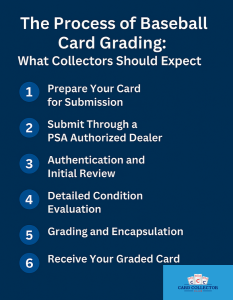For many collectors, baseball cards are more than memorabilia—they’re investments, heirlooms, and historical artifacts rolled into one. But what truly separates a valuable card from the rest? One of the biggest factors is its grade.
Whether you’re new to the hobby or refining your collection for resale, understanding the process of baseball card grading is essential. In this guide, we’ll walk you through the grading process step-by-step, explain what affects a card’s final grade, and how working with a PSA Authorized Dealer like Card Collector Club can make all the difference.

Why Grade a Baseball Card?
Grading isn’t just about appearance—it’s about trust. A professionally graded card offers:
- Verified authenticity
- Condition-based market value
- Protection against fraud or tampering
- Buyer confidence for sales or auctions
In short, grading can dramatically increase a card’s value, especially if it earns a high mark.
Step 1: Prepare Your Card for Submission
Before a card is graded, it must be carefully prepared. At Card Collector Club, we offer card prep services that include placing cards in sleeves and semi-rigid holders to minimize damage during shipping. Proper preparation is critical—flaws like edge fraying or surface marks can reduce your card’s grade.
Need help getting your cards ready? Explore our Grading Services for more info on card prep and submission support.
Step 2: Submit Through a PSA Authorized Dealer
Submitting directly to a grading company can be confusing and time-consuming. That’s why working with a PSA Authorized Dealer like Card Collector Club provides a serious advantage.
As a trusted intermediary, we offer:
- Faster submission turnaround times
- Expert handling to avoid damage
- Bulk discounts and group submission options
- Priority service with PSA
You can start your submission today by reaching out through our Contact Page or by joining our secure submission platform.
Step 3: Authentication and Initial Review
Once your card is submitted, the grading process begins with authentication. This step ensures that the card is genuine—not a reprint or counterfeit.
Authentication includes:
- Verifying printing methods, ink, and materials
- Comparing the card to known authentic examples
- Reviewing manufacturer details, logos, and trademarks
If the card passes, it moves on to condition evaluation.
Step 4: Detailed Condition Evaluation
The core of baseball card grading lies in assessing its physical condition. PSA and other reputable companies use a 10-point scale, with 10 being Gem Mint and 1 being Poor. Here’s what experts look for:
1. Centering
How well the image is aligned within the card’s borders. Even slightly off-center images can drop the grade.
2. Corners
Sharp corners are a sign of a mint card. Rounded, dinged, or frayed corners will lower the grade significantly.
3. Edges
Clean, smooth edges are ideal. Chipping or edge wear—especially with dark-bordered cards—affects the score.
4. Surface
This includes gloss, print clarity, and any marks or scratches. Stains, creases, or residue can cause major deductions.
Step 5: Grading and Encapsulation
After evaluation, the card is given a grade. PSA’s grading scale ranges from PR 1 (Poor) to GEM-MT 10 (Gem Mint). A card graded 9 or 10 typically fetches premium prices on the secondary market.
Once graded, the card is encapsulated in a tamper-proof, hard plastic case featuring a certification label. This not only protects the card but also confirms its legitimacy and grade for potential buyers.
Step 6: Receive Your Graded Cards
Once grading is complete, your card is shipped back securely. At Card Collector Club, we monitor the process from start to finish and provide tracking for all returns. You’ll also receive a certified PSA label and access to PSA’s verification database.
What Affects Your Final Grade?
Even minor imperfections can reduce a card’s grade. Here are a few common grading factors to watch out for:
- Handling Damage: Fingerprints, oils, or accidental drops.
- Storage Issues: Exposure to light, moisture, or poor casing.
- Manufacturing Defects: Print lines or centering flaws may impact new cards.
- Aging: Vintage cards naturally degrade over time, but proper preservation helps.
This is why submitting your cards through a professional grading service with a PSA Authorized Dealer is so important—it minimizes risks and maximizes results.
The Card Collector Club Advantage
We’re more than a submission service—we’re collectors, advisors, and partners in your hobby. When you grade with Card Collector Club, you receive:
- Secure handling and storage
- Expert pre-grading consultation
- Group and bulk submission discounts
- Full transparency throughout the grading journey
Plus, with our upcoming Card Consignment Dashboard, you’ll be able to grade and sell your cards in one streamlined process.
Learn more about who we are on our About Page.
Final Thoughts: Grade With Confidence
Grading your baseball cards is one of the best steps you can take to protect and grow your collection. From increasing resale value to preserving sentimental favorites, professional grading ensures your cards stand the test of time.
If you’re ready to grade your cards, let Card Collector Club be your trusted PSA Authorized Dealer.
Contact us today to get started or visit our Grading Services Page for more details!
